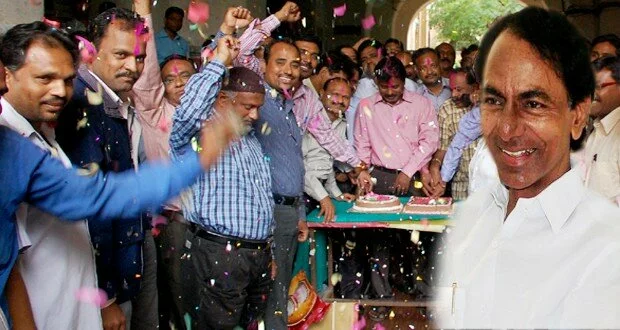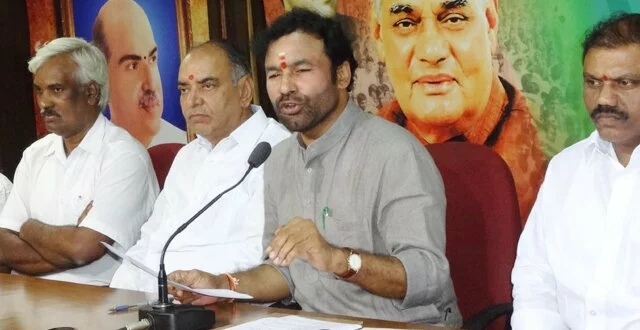Hyderabad, Feb 18 : The movement seeking statehood for Telangana region is as old as the State of Andhra Pradesh itself.
The Telangana movement has seen many ups and downs in the last four decades. It witnessed bloodshed and violence. Hundreds of youth committed suicide for the cause. There were two big political movements that gave the statehood agitation a new direction. In 1971, the Telangana Praja Samithi swept the polls in the name of statehood only to merge itself with the ruling Congress party later.
Three decades later, on April 27, 2001, it was K Chandrasekhar Rao who revived the Telangana movement by launching Telangana Rashtra Samithi. In view of past experience, doubts were raised on his real intentions. However, sustained movement, especially in the rural areas revived the hopes that Telangana could be a reality in future. Out of power for a decade, the Congress party was quite desperate to return to power in 2004 elections. But the presence of TRS in Telangana posed a major threat to its success although the popularity graph of the then Chief Minister N Chandrababu Naidu and TDP Government was at an all-time low before the elections.
To avoid split of votes and consequent benefit to the TDP, the Congress party entered into an alliance with the TDP. It was primarily to counter the TDP which forged an alliance with the BJP to prevent the division of votes of right-wing sympathisers.
The TRS was able to win 26 out of 42 Assembly and five out of six Lok Sabha seats that it contested. This political strength has completely changed the dynamics in favour of demand for Telangana State. The statehood demand got a mention in the Presidential Address in Parliament. This was the first milestone at the national level and its echo was continuously heard in future.
However, the TRS and Congress could not continue their relationship for a long time. In September 2006, the TRS withdrew its support given to the Congress-led United Progressive Alliance Government at the Centre. It suspected that the Congress party would not keep up its promise of giving statehood for Telangana region. The decision led to a war of words between the TRS and Congress leadership. To prove his might and the strength of sentiments for separate Telangana, KCR resigned as Lok Sabha member from Karimnagar seat forcing a by-election. By winning the seat again in the by-elections, this time with a strong majority, KCR proved that Telangana sentiments were at their peak.
However, a similar move in April 2008 proved too costly for the party. Demanding that the Centre grant statehood for the region, all TRS MLAs and MPs resigned from their positions. In the by-elections held on May 29, 2008, the TRS could win only seven out of 16 Assembly and two out of four Lok Sabha seats. This defeat had a negative impact on the Telangana sentiments and this was reflected in 2009 General Elections. Despite being an ally of TDP-led Grand Alliance, the TRS could win only 10 Assembly and two Lok Sabha seats.
The death of the then Chief Minister Dr YS Rajasekhara Reddy created a vacuum in the Congress leadership in the State. YSR’s successor K Rosaiah was unable to keep a tab on his political opponents, both within and outside the government. Taking advantage of the political situation, KCR went aggressive and launched a fast-unto-death in November 2009. Despite deterioration of health, he refused to break the fast until the Centre accepts the demand for Telangana.
Finally, on December 9, 2009, the Centre accedes to the demand for Telangana State. The then Home Minister P Chidambaram announced that the Centre would start the process of Telangana formation. The announcement was followed by celebrations across the region. However, the joy was short-lived and the Centre withdrew its decision on December 23 following mass resignations by the MLAs from Rayalaseema and coastal Andhra regions.
The again, led to a series of protests in the region. The Congress-led UPA Government then constituted Sri Krishna Committee on February 3, 2010, to study the Telangana demand. The Committee held consultations with various groups, received thousands of representations and submitted its report to the Centre. But this deteriorated the political situation further. The 505-page report released by the Centre on 6th January 2011 contained several observations and the committee made six suggestions including the bifurcation of State.
The region then witnessed unprecedented protests including Million March, Sakala Janula Samme (General Strike) by the employees of Telangana region, Telangana March and other protests. Over 1,000 youth committed suicide in different parts of the region. The TRS continued its political pressure by forcing another by-election. All legislators from the region belonging to other parties were also forced to submit their resignations although not all resignations were accepted by Speaker Nadendla Manohar.
The protests spilled from one year to another and the last mass protest was Chalo Assembly Rally organised by Telangana Joint Action Committee on 14th June 2013.
Several senior leaders including two sitting MPs – Manda Jagannatham and G Vivekananda and former PCC chief K Keshava Rao quit the Congress party to join TRS. The influx into TRS gained momentum with leaders from Congress and TDP coming out of their parties over the statehood issue. The situation turned worse for the Congress party in Andhra Pradesh. While YSR Congress Party made its base strong in Seemandhra region by sweeping the by-elections, it became almost impossible for the Congress leaders to move freely in Telangana region, especially in rural areas. Sensing that it would be impossible for the Congress party to survive in Telangana if it fails take a favourabe decision, the party began the process of consultations on the issue.
Finally on July 30 this year, the Congress Working Committee passed a resolution favouring bifurcation of Andhra Pradesh to carve out Telangana State. The CWC resolution got the nod of Union Cabinet on 3rd October. A Group of Ministers (GoM) was then constituted to implement the process of bifurcation. The GoM held another round of consultation and finalised the draft Andhra Pradesh Reorganisation Bill 2013.
President of India Pranab Mukherjee then referred the Telangana Bill to the State Legislature on December 12 while setting January 23 as the deadline to give its views. The Bill was tabled in both the Houses on December 16 and following the extension of deadline by one week, the debate concluded on January 30. As many as 86 MLAs spoke on the bill and 9,072 amendments were sought by other members. The Assembly rejected the Bill through a resolution moved by Cheif Minister N Kiran Kumar Reddy.
Amid protest and even some violence by the Seemandhra MPs, the Telangana Bill was introduced and passed in the Lok Sabha on Tuesday. INN
 INN Live News – India Breaking News, Headlines, Hyderabad اردو خبریں
INN Live News – India Breaking News, Headlines, Hyderabad اردو خبریں

